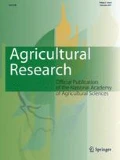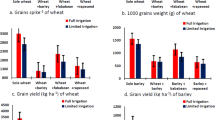Abstract
A study was undertaken for using Umbelliferous spices, coriander, fenugreek and fennel as intercrop with chickpea in 2:1, 3:1 and 4:2 row ratios, each separately with their respective sole treatments during the winter season 2010–2011, to determine the effect of different intercropping systems on productivity and competitive functions. The yield of chickpea increased progressively with the increase in number of rows of chickpea in every intercropping system. All the intercropping systems produced higher land equivalent ratio (LER) than their respective sole cropping. Chickpea and fennel (4:2 row ratio) recorded higher benefit in terms of monetary advantage index (MAI) (Rs. 6990 ha−1), income equivalent ratio (IER) (2.03), system productivity index (SPI) or intercropping advantages (IA) among the all the intercropping systems. All the three spices performed as a dominant component, while chickpea was suppressed, and higher competition was noticed when coriander was taken as an intercrop, while competition was less in chickpea and fennel intercropping system.
Similar content being viewed by others
References
Abraham T, Sharma UC, Thenua OVS, Shivakumar BG (2010) Effect of levels of irrigation and fertility on yield and economics of chickpea (Cicer arietinum) and Indian mustard (Brassica juncea) under sole and intercropping systems. Indian J Agric Sci 80(5):372–376
Ahlawat IPS, Gangaiah B, Ompal Singh (2005) Production potential of chickpea (Cicer arietinum) based intercropping systems under irrigated conditions. Indian J Agron 50(1):27–28
Awasthi UD, Tripathi AK, Dubey SD, Kumar S (2011) Effect of row ratio and fertility levels on growth, productivity, competition and economics in chickpea + fennel intercropping system under scarce moisture condition. J Food Legumes 24(3):211–214
Banik P (1996) Evaluation of wheat (T. aestivum) and legume intercropping under 1:1 and 2:1 row-replacement series system. J Agron Crop Sci 176:289–294
Banik P, Midya A, Sarkar BK, Ghose SS (2006) Wheat and chickpea intercropping systems in an additive series experiment: advantages and weed smothering. Eur J Agron 24:325–332
DeWilt CT (1960) On competition. Verslag Land-bouwkundige Onderzoek 66(8):1–82
Dhaka AK, Satish Kumar, Pannu RK, Ratneswar Poddar, Bhagat Singh, Dhindwal AS (2014) Performance of seed crop of prickly sesban or dhaincha (Sesbania aculeata) when intercropped with pearlmillet (Pennisetum glaucum). Indian J Agron 59(1):70–75
Dhima KV, Lithourgidis AS, Vasilakoglou IB, Dordas CA (2007) Competition indices of common vetch and cereal intercrops in two seeding ratio. Field Crops Res 100:249–256
FAO (2010) Food and Agriculture Organization of the United Nations. faostat.fao.org
Grime JPL (1977) Evidence for the existence of three primary strategies of plants and its relevance to ecological and evolutionary theory. Am Nat 111:1169–1174
Hiebsch CK, Macollam RE (1980) Area time equivalency ratio. A method for evaluating the productivity of intercrops. Agron J 79:15–22
Kumar A, Singh BP (2006) Effect of row ratio and phosphorus level on performance of chickpea (Cicer arietinum)-Indian mustard (Brassica juncea) intercropping. Indian J Agron 51(2):100–102
Lithourgidis AS, Dordas CA, Damalas CA, Vlachostergios DN (2011) Annual intercrops: an alternative pathway for sustainable agriculture. Aust J Crop Sci 5:396–410
McGilchrist CA (1965) Analysis of competition experiments. Biometrics 21:975–985
Midya A, Bhattacharjee K, Ghose SS, Banik P (2005) Deferred seeding of blackgram (Phaseolus mungo L.) in rice (Oryza sativa L.) field on yield advantages and smothering of weeds. J Agron Crop Sci 191:195–201
Mishra JP, Masood A, Arya RL (2001) Genotypic compatibility in relation to row ratio in the intercropping of linseed (Linum usitatissimum) and gram (C. arietinum) under rainfed conditions. Indian J Agric Sci 71(6):359–362
Mullick SP, More SM, Despandey SS, Patil JD (1993) Intercropping for better stability in dry land watersheds. Indian J Agron 38(4):527–530
Odo PE (1991) Evaluating short and tall sorghum varieties in mixtures with cowpea in Sudan Savanna of Nigeria: LER, grain yield and system productivity index. Exp Agric 27:435–441
Rao MR, Mathuva MN (2000) Legumes for improving maize yields and income in semi-arid Kenya. Agric Ecosyst Environ 78:123–137
Tanwar SPS, Rakadia P, Singh AK (2011) Effect of row ratio and fertility levels on chickpea (Cicer arietinum) and linseed (Linum usitatissimum) intercropping system. Indian J Agron 56(3):217–222
Thorsted MD, Weiner J, Olesen JE (2006) Above- and below-ground competition between intercropped winter wheat Triticum aestivum and white clover Trifolium repens. J Appl Ecol 43:237–245
Willey RW (1979) Intercropping, its importance and research needs. Part-I. Competition and yield advantages. Field Crop Abstr 32(1):1–10
Willey RW (1990) Resources use in intercropping system. Agric Water Manage 17:215–231
Author information
Authors and Affiliations
Corresponding author
Rights and permissions
About this article
Cite this article
Poddar, R., Kundu, R. & Kumar, S. Assessment of Chickpea-Spices Intercropping Productivity Using Competitive Indices Under Irrigated Conditions of Haryana. Agric Res 6, 241–247 (2017). https://doi.org/10.1007/s40003-017-0260-z
Received:
Accepted:
Published:
Issue Date:
DOI: https://doi.org/10.1007/s40003-017-0260-z




